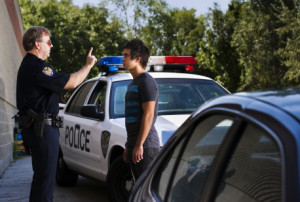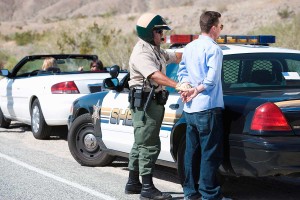Driving while impaired (DWI) presents a complex set of challenges, including criminal sanctions through the judicial process and driving restrictions via the Department of Motor Vehicles. This type of crime touches upon the broad spectrum of the populace, and for many, is their first encounter with the criminal justice system. Being charged with a DWI can be a stressful and frightening experience. However, not all hope is lost. Many DWI charges can be handled proactively. As a disclaimer, every case is different and the mechanisms used to attack each case vary depending on the facts presented. This should serve as an overview to help point you in the right direction.
History
As the United States developed a more intricate highway system in the 1960s and 1970s, the automobile became increasingly more important. The exponential increase of vehicles on the road paralleled with an increase of impaired drivers on the road. To combat this growing problem, the National Highway Traffic Safety Administration (NHTSA), conducted research studies to uncover the most accurate tools for discovering and prosecuting potentially impaired drivers. This research spawned a three-phase process for officers to investigate possible driving while impaired violations. As a caveat, NHTSAs program is the gold standard for DWI investigations, if followed correctly by the officer. However, many officers have not completed the NHTSA field sobriety test training and trained officers can make mistakes in the process. Knowing how the investigation works is critical for finding potential avenues to address the charges.
Vehicle in Motion Phase
As previously mentioned, the NHSTA DWI investigation breaks down into three parts; the Vehicle in Motion phase, the Personal Contact phase, and the Pre-Arrest Screening phase. The Vehicle in Motion phase is dominated by one question in the officer’s mind: “should I pull this vehicle over?” The officer is looking for 24 potential cues of impairment a driver may display. These cues range from failing to maintain lane indicators (swerving, weaving, drifting, etc.) to vigilance problems (failure to put on headlamps and slow response time to traffic signals). Speeding (one of the most common reasons for a traffic stop) is NOT one of the 24 cues of impairment. For example, if speeding is the only reason you were pulled over, it can be argued that your driving did not exhibit any signs of impairment.
Personal Contact Phase
Once the vehicle is pulled over, the Personal Contact phase begins. Here, the officer is trying to determine whether he/she should ask the driver to step out of the vehicle. The officers are trained to use their senses to gather evidence of impairment. The most common attributes officers look for include red glassy eyes, odor of alcohol, and slurred speech. Officers will often ask “have you had anything to drink tonight?” They will also ask interrupting or distracting questions, such as what time is it without looking at a clock or count down from 67 to 53. These questions are designed to make the driver feel uncomfortable and elicit signs of impairment. If the officer asks the driver to step out of the vehicle, the third phase of the investigation begins, Pre-Arrest screening.
Pre-Arrest Screening Phase
 The Pre-Arrest screening phase is the heart of the DWI investigation. The underlying question for the officer is whether he should arrest the driver. This phase revolves around Standard Field Sobriety Tests (SFSTs). NHTSA’s research has concluded there are three SFSTs and if administered correctly, they can proficiently estimate a person’s blood alcohol concentration (BAC). The key mode of attack here is to challenge the officer’s knowledge of the tests and their associated clues. Failing to administer these tests according to the standardized guidelines sheds them of their objectivity, thus making them unreliable for purposes of showing a driver’s potential BAC. Driving requires divided attention (doing multiple tasks at once). These SFSTs are designed to challenge a driver’s ability to divide his attention.
The Pre-Arrest screening phase is the heart of the DWI investigation. The underlying question for the officer is whether he should arrest the driver. This phase revolves around Standard Field Sobriety Tests (SFSTs). NHTSA’s research has concluded there are three SFSTs and if administered correctly, they can proficiently estimate a person’s blood alcohol concentration (BAC). The key mode of attack here is to challenge the officer’s knowledge of the tests and their associated clues. Failing to administer these tests according to the standardized guidelines sheds them of their objectivity, thus making them unreliable for purposes of showing a driver’s potential BAC. Driving requires divided attention (doing multiple tasks at once). These SFSTs are designed to challenge a driver’s ability to divide his attention.
The first and most reliable of the SFSTs is the Horizontal Gaze Nystagmus test. During this test, the officer is looking for nystagmus, or involuntary movmement of the eyes, which is caused by central nervous depressants, including alcohol. Before the officer starts the test, he must medically clear the driver. The officer must verify that no resting nystagmus is present, the driver has equal pupil sizes, and the driver’s eyes track equally. Once medically cleared, the officer can conduct the test. There is a total of 6 clues (3 in each eye) that the officer is trained to look for: Lack of Smooth Pursuit, Distinct and Sustained Nystagmus at Maximum Deviation, and Onset of Nystagmus Prior to 45 degrees. If a driver exhibits 4 out of 6 clues, NHTSA research indicates there is an 88% chance that his BAC is .08 or higher.
The next test is the Walk and Turn. Before starting the test, the officer should ask if the person has any knee, back, or leg problem that would prevent him from performing the test. The driver is instructed to walk on an imaginary line heel to toe for 9 steps, to make a small turn to his left, and then walk on the line for another 9 heel to toe steps. Proper instruction is critical. For instance, the officer must instruct and demonstrate to the driver to put his right foot in front of his left foot. Otherwise, the 9th step the driver takes will be on his right foot and it will cause the driver to make an improper turn. The test is broken down into two parts: the instruction phase and walking phase. During the instruction phase, the officer is looking for 2 clues: failure to maintain balance and starting the test too soon. The second part is the walking phase, where the officer is looking for 6 clues. The 6 clues are: stops walking during the test, fails to step heel to toe, steps off the line, raises arms to balance, makes an improper turn, and takes the incorrect number of steps. If a driver exhibits 2 out of the total of 8 clues, then there is a 79% chance the driver has a BAC of .08 or higher.
The third SFST is the One Leg Stand (OLS). After the officer medically clears the suspect, the officer will instruct the suspect to raise either leg in the air, 6 inches above the ground, keeping his foot parallel to the ground. The suspect will be instructed to count out loud until, instructed to stop by the officer. During this test, the officer is looking for a total of 4 clues: puts foot down, uses arms to balance, swaying, and hopping. If a driver exhibits 2 out of the 4 clues, there is an 83% the driver has a BAC of .08 or higher.
 It is important to note that all of the SFSTs are voluntary, although many officers are not required to disclose this fact. Also, in many DWI investigations, the officer will administer a Portable Breath Test (PBT) on the potentially impaired driver. The PBT is also a voluntary test. Because the PBT has not been deemed sufficiently reliable to be used as evidence in court in North Carolina, the numerical result is not admissible. The officer can only testify as to whether the PBT came back positive or negative. The NHTSA handbook states that the PBT should only be used to validate an officer’s opinion that a suspect is impaired after a thorough investigation takes places.
It is important to note that all of the SFSTs are voluntary, although many officers are not required to disclose this fact. Also, in many DWI investigations, the officer will administer a Portable Breath Test (PBT) on the potentially impaired driver. The PBT is also a voluntary test. Because the PBT has not been deemed sufficiently reliable to be used as evidence in court in North Carolina, the numerical result is not admissible. The officer can only testify as to whether the PBT came back positive or negative. The NHTSA handbook states that the PBT should only be used to validate an officer’s opinion that a suspect is impaired after a thorough investigation takes places.
As discussed earlier, the three-pronged DWI investigation is the gold standard. In many cases, not all phases will be present. For instance, if the officer arrives to the scene of an accident, the vehicle in motion phase would not have occurred. Phase 1 will also not be present when a driver is stopped at DWI checkpoint. Checkpoints provide an interesting twist. Not only can the officer’s investigation be attacked, the checkpoint itself can be attacked as well. The United States Supreme Court has upheld DWI roadblocks as constitutional, but certain procedures must be followed by law enforcement. The agency must have a set plan in place before the roadblock is conducted and it must address the following: which cars will be stopped, how will the cars be stopped, and how the roadblock must be clearly demarcated.
Phase 3 of the investigation may not take place because the officer may not have an opportunity to administer SFSTs. For example, if an officer first encounters the suspect in the hospital. The three-part DWI investigation is the primary method used by officers to establish probable cause for an arrest. Thus, knowing the proper procedure can open up possible avenues to attack the arrest, such as failing to properly administer SFSTs or not administering them at all.
Attacking your DWI charges
With the framework of a DWI investigation established, we will next dive into five methods to attack a DWI charge. Every case is different and each set of facts will dictate which defenses are available. It is imperative to know all of the possible avenues of attack to see if any of these apply to your case. Our first attack point is to challenge the stop by the officer. When an officer conducts a traffic stop, they are only required to have reasonable suspicion to initiate a stop. Reasonable suspicion is a relatively low threshold to meet and only requires there be some objective reason for the stop: something more than just a hunch. As previously mentioned, observing 1 of the 24 cues of impairment can give an officer reasonable suspicion to pull over a vehicle.
Challenging the Arrest
Another prominent way to attack a DWI is to challenge the arrest (the officer lacked requisite probable cause to arrest the suspect). Once the officer formally arrests a suspect, she must have probable cause to do so. At every stage of the DWI investigation, look for mistakes the officer may have made or what the officer did not note in his field report. The probable cause inquiry centers around the officer’s investigation prior to the arrest of a suspect. To attack probable cause, it is imperative to show how the officer’s investigation deviated from the Gold Standard DWI investigation discussed above. It is critical to know which, if any, of the SFTS the officer conducted and the instruction the officer gave for the tests. If the officer failed to correctly explain or administer a test, the test would be ripe for scrutiny. Many officers use a portable breath test during a DWI investigation. These devices have been found to be insufficiently reliable and thus the numerical results of these tests are not admissible in court. If an officer does use this numerical value in making his arrest decision, which would be discovered through cross-examination, another avenue for attack presents itself. The requisite statute and accompanying case law make it clear officers are prohibited from using the PBT device in making an arrest decision. Otherwise, the officer’s actions would not be subject to judicial review. If the numerical result is not admissible in court and an officer uses that number in determining whether to arrest a suspect, a judge will not know how much the officer relied on that result in making his decision. It is imperative to know the ins and outs of the SFTS. The incorrect administration of these tests or the failure to use these tests can be powerful ammunition for attacking a DWI arrest.
After the arrest occurs, additional modes of attack may become relevant. The first challenge revolves around the intoxilyzer room or the breath test room. These are commonly referred to as Ferguson and Knoll issues. At the jail, the officer will read the suspect his implied consent rights (by the mere implication of driving, a person consents to give a chemical sample to law enforcement if charged with driving while impaired) as to chemical testing. The suspect must be made aware of his right to refuse, which can be used against him as substantive evidence of impairment and his right to have a witness available if he chooses to provide a chemical sample. The suspect can either blow into an intoxilyzer at the jail or provide a blood sample. If an officer fails to read the suspect his implied consents rights or fails to allow adequate time for a witness to be present (30 minute window), then the chemical test is ripe for attack and can potentially be suppressed. Failing to advise the suspect of his right to have a witness or not allowing the witness to enter the breath test room brings into play State v. Ferguson and its progeny. Another issue that arises after the arrest of the suspect is the duration of his stay in the jail. The magistrate is required to advise all recent arrestees of the charges against them, the right to communicate with counsel and friends, and the conditions under which they may obtain their release. Not allowing a suspect to have access to counsel and friends prevents him from gathering potential evidence of his sobriety through his witness’s observations. Alcohol dissipates in the body so there is a limited window available for a suspect to gather evidence. A prolonged jail stay without justification is another avenue to attack a DWI following the argument that the driver was denied the ability to confront the witnesses against him.
In some cases, a blood sample is taken from a suspect. There are many issues that can arise in relation to a blood sample. Did the officer read the suspect his implied consent rights? Was there a search warrant executed for the blood? Did the search warrant comport with requirements of the 4th amendment? Was there probable cause to take the driver’s blood? By who and where was the blood taken? Was the correct chain of custody procedure followed? Blood results can take months to be processed and when the results are returned, the district attorney will provide notice to the defendant/defendant’s attorney.
Contact Us
If you have been charged with DWI / DUI in North Carolina, it is imperative that you contact an experienced DWI attorney today, to see how they can assist you in navigating the charges most effectively. Minick Law offers free consultations for DWI cases, call today to see how we can help. (828) 333-5024
From our blog:




























